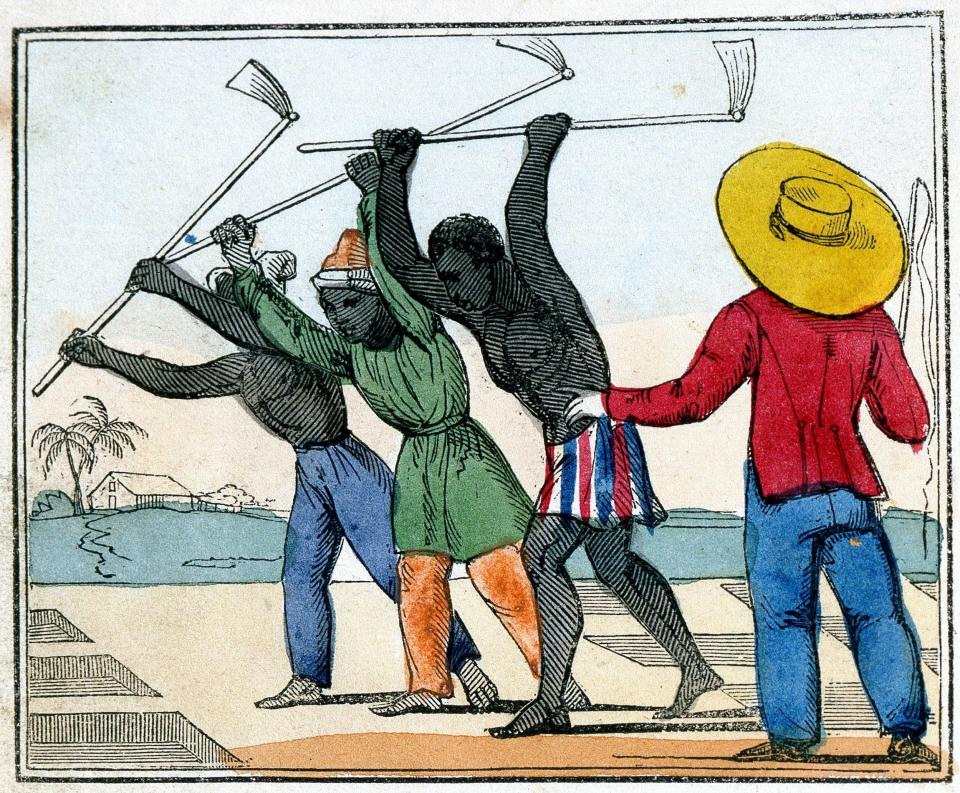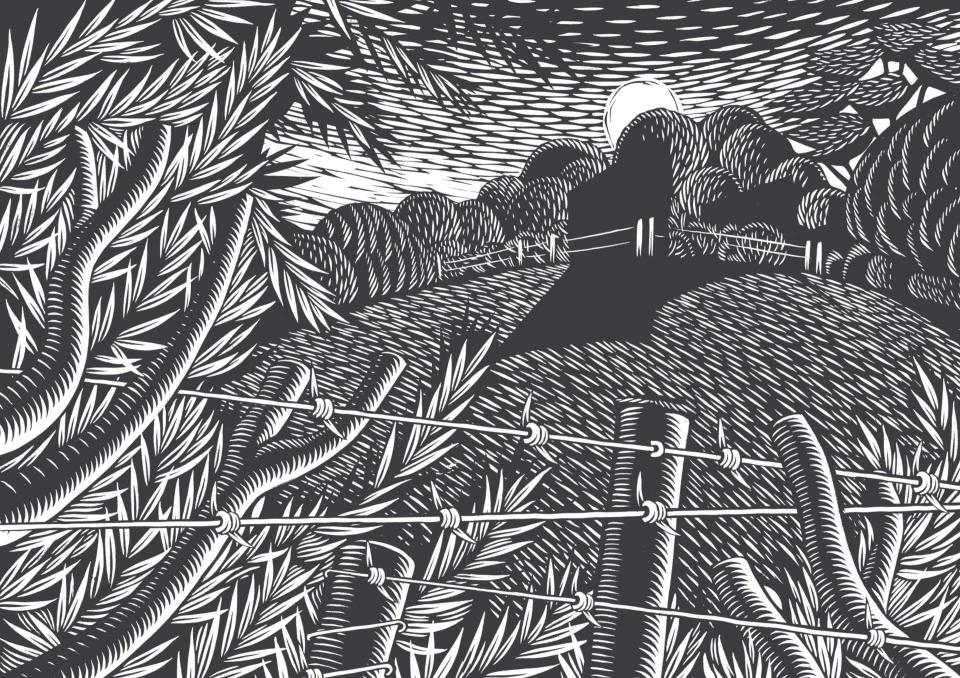A very English theft: how the countryside was taken from the public, using profits from slavery

A couple of years ago, I approached the longest wall in England. I put my hands on its ledge, lifted myself up and climbed into 7,000 acres of private land belonging to the representative of South Dorset, Richard Drax MP.
It was a work trip. I was researching my new book, The Book of Trespass, a history of how the English countryside was partitioned. I spent an entire year hopping the walls of the dukes, lords, media magnates and private corporations that own England, looking for the origin of trespass and tracing the history of the privatisation of land – or in other words, the public’s exclusion from nature.
This wall, surrounding the grounds of Charborough House, was of particular interest to me. It was built by Richard Drax’s ancestor, John Sawbridge, who married into the Drax dynasty, and who was able to finance the build following a recent windfall from his sugar-cane estates in the Caribbean – although the money came not from his sugar, but from his slaves.
James Drax first landed in Barbados in 1627. He cleared the land for farming, planted tobacco, watched it repeatedly fail, then looked to the Dutch colonies in Brazil for a better idea: sugar. His estates were first worked by the indentured servants rounded up as vagrants or “sturdy beggars” in England and Ireland, and sent to the colonies as punishment. But within a decade he was importing even cheaper labour – free, in fact – in the form of enslaved people from West Africa.
As more and more Englishmen landed on the Caribbean, cut down the trees, ploughed the land and began sugar production, the countryside back home in England also began to change. The slave traders and colonialists were making quick money in the Caribbean and heading home to translate this wealth into landed property.
Property legitimised their wealth: not only did they ape the architecture of aristocratic castles and mansions, their deer parks and sculpted gardens, but their newly purchased land also bought them seats in an unreformed parliament, whose votes were directly linked to the amount of land you possessed. As foreign land was claimed by the colonialists, so more common land of England was claimed by their profits.

All across the west coast of England, new estates were built, or old ones bought and remodelled, as a direct result of slavery. From the late 1600s to the early 1900s, it is estimated that one-sixth of Britain’s country houses were bought by businessmen whose fortunes were sourced from colonial trade. The sugar barons made the most money, but it was also the moneylenders, the investors, the chain-makers and the ship-builders that boomed.
The Drax family were surrounded by other wealthy dynasties in the Caribbean just as they were surrounded in England. The Beckfords, owners of massive estates in the Caribbean, settled in Fonthill, just 20 miles up from Charborough; the Codringtons bought up land just outside of Bristol, in Dodington Park, now home to entrepreneur James Dyson.
The interior of the Drax estate tells a silent story of what the colonialists did with their property. The purchase of land secured a firmer grip on power, not just in one lifetime, but for many generations to come. Farming, forestry, pleasure gardens, hunting, shooting – all of these became reliable sources of income, an accumulation of private profit in direct proportion to the dispossession of the commonwealth. In fact, what happened abroad – the mining of minerals, the rent on land, the dispossession of the locals – were colonial methods first practiced on English soil, as the landlords colonised the commons at home.
At Charborough, my friend and I wandered for several miles across the estate. (For an MP who once stood up during an immigration debate in Parliament to declare “this country is full”, there’s certainly a lot of empty space behind Drax’s walls.) Eventually, while making our way through planted pines, we were discovered by a gamekeeper. There’s no way through here, he said, evidently expecting my friend and I to ignore the path on which all three of us were standing. Very politely, and in no uncertain terms, we were chucked off the land.

While the stray rambler knows what it feels like to be unwelcome in the countryside, for black and minority people there are greater barriers than just brick walls and barbed wire. In 2011, a report from the University of Leicester, titled Rural Racism, said: “Minority ethnic incomers were often treated with suspicion, as many white rural residents felt that they belonged only in the city, with all its concomitant ‘negative’ attributes of noise, pollution, crime and, crucially for some, multiculturalism.”
And people of colour may feel unwelcome in the countryside in part because English rural estates are walled by the profits of colonialism, littered with monuments to the subjugation of their ancestors. Until recently, this perspective on the landscape of England has been largely overlooked. During the 2010 election campaign, when asked about his own family’s connection to slavery, Richard Drax replied: “I ignore it.” Blunt, but effective, especially since the education system and institutions of England have followed the same approach.
But now the National Trust are leading the way in exposing the cultural legacy of slavery and colonialism in the countryside, using the buildings for which they care to retell the story of our colonial past. Their forthcoming report (co-authored with Professor Corinne Fowler at the University of Leicester) highlights that a third of their properties have links to slavery and colonialism. The Trust is integrating this colonial history into its online and on-site narratives, as well as removing, re-interpreting and redisplaying relevant objects in their collections.
Many groups across England are spearheading a drive towards a more inclusive countryside. Black Girls Hiking, Righttoroam.org.uk, Wild in the City and CPRE are all organisations concerned with overcoming the myth that “black” automatically means “urban”, promoting the bizarrely radical notion that a love of nature, a need for open air, is not contingent on the colour of one’s skin.

Other groups, such as The Land Workers Alliance and Land in Our Names, campaign for greater access to land for the growing of food. They believe that facilitating black and ethnic minority groups to grow their own food – to farm in the English countryside – should effectively be seen as reparations for slavery.
Reparation is about parity, the active enabling of equality: re-telling the story is not enough; apologising for colonialism is not enough; pragmatic steps must be taken to reverse the iniquity and psychic damage done to the English citizens who are the descendants of enslaved people. “Racism,” according to Land in Our Names, “is a structural and systemic problem that needs reparative justice in order to stop the unnecessary violence that people of colour experience.”
Here’s a radical idea: racism is more alive today than it ever was in the slavery era. In the words of Eric Williams, the first prime minister of Trinidad and Tobago, and author of the 1944 book Capitalism and Slavery: “The reason (for slavery) was economic, not racial. It had to do not with the colour of the labourer, but the cheapness of the labour. Slavery was not born of racism: rather, racism was the consequence of slavery.”
The concept of race itself was a quasi-scientific lie, concocted on the sugar farms of the Caribbean as a way of dividing the solidarity between white indentured servants and the enslaved Africans. In 1661, the English authorities passed The Act of Better Ordering and Governing of Negroes on Barbados. By banning miscegenation (sex between races) and giving privileges to the white workers, it gave race a salience it never had before.
Even so, the white workers, both in the Caribbean and back in England, took a long time to fall for the ruse. The 1661 Act didn’t work; the Irish and Africans together plotted two major slave uprisings in 1686 and 1692, and to this day there are many Murphys, McDonnoughs and McGanns in the Caribbean phone book. Likewise, at home, racism took a long time to take off. The Anti-Corn Law League saw slavery as a violent, extreme extrapolation of what was happening to the white workers of England. To them, the divide between black and white was a smokescreen to mask the fundamental issue: the exploitation of labour and land, the idea that certain sectors of society should have a greater share of the world than others.

Which brings us back to Charborough, and the wall around the estate of Richard Drax MP. If you’re looking for a date when racism became officially institutionalised in England, December 23 1837 would be a good start. On that day, the Slave Compensation Act was passed, and enslaved Africans were officially defined by law as the “inalienable property of their masters”. Of course, the slaves themselves weren’t paid a penny; the funds were designated to compensate the “property” owners for their losses, funded by the British taxpayer.
Richard Drax’s wall, in other words, constructed in 1841–2, was built by the commoners it excluded, and paid for by a nation who subsequently lost the value of the land it enclosed. The story of the English countryside is a history of the interests of a few men overriding the interests of everyone else, using their power to legitimise their exploitation. While we continue to accept the legitimacy of widespread public exclusion from the countryside, we continue to nourish the lie of just and natural white supremacy – because as history tells us, they are one and the same thing.
The Book of Trespass: Crossing the Lines that Divide Us is published tomorrow by Bloomsbury at £20. To order your copy, call 0844 871 1514 or visit the Telegraph Bookshop

